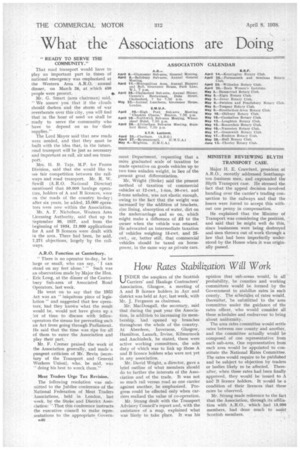How Rates Stabilization Will Work U NDER the auspices of the
Page 74

If you've noticed an error in this article please click here to report it so we can fix it.
Scottish Carriers' and Haulage Contractors' Association, Glasgow, a meeting of A and B licence holders in Ayr and district was held at Ayr, last week, with Mr. J. Ferguson as chairman.
Mr. MacDougall, the secretary, said that during the past year the Association, in addition to increasing its membership, had opened up branches throughout the whole of the country. At Aberdeen, Inverness, Glasgow, Hamilton, Lanark, Irvine, Kilmarnock and Auchinleck, he stated, there were active working committees, the sole duty of which was to link up those A and B licence holders who were not yet in any association.
Mr. David Wright, a director, gave a brief outline of what members should do to further the interests of the Association and of the trade. It was not so much rail versus road as one carrier against another, he emphasized. Progress could be effected only when carriers realized the value of co-operation.
Mr. Strang dealt with the Transport Advisory Council's report and, with the assistance of a map, explained what was likely to take place. It was his opinion that sub-areas would, in all probability, be counties and working committees would be formed by the Government to stabilize rates in each county. The schedtiles of rates would, thereafter, be submitted to the area committee under the guidance of the rates officer, who would consider all these schedules and endeavour to bring about uniformity.
The area rates committee would settle rates between one county and another, and the committee actually would be composed of one representative from each sub-area. One representative from each area would be appointed to constitute the National Rates Committee. The rates would require to be published and be subject to objection by traders or bodies likely to be affected. Thereafter, when these rates had been finally approved, they would be issued to A and B licence holders. It would be a condition of their licences that these rates he observed.
Mr. Strang made reference to the fact that the Association, through its affiliation with A.R.O., which had 15,000 members, had done much to assist Scottish members.






















































































































